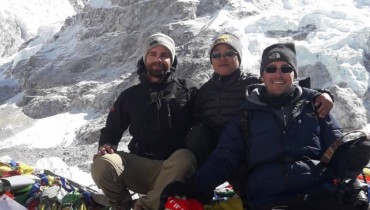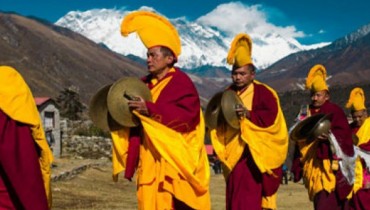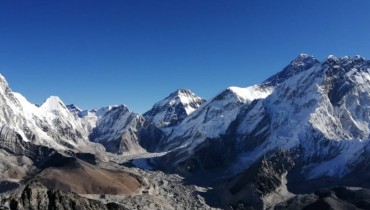Mt. Ama Dablam Expedition – Climbing Guide

Quick Facts About Mt. Ama Dablam Expedition
Here are some quick facts about Mt. Ama Dablam Expedition:
- Mt. Ama Dablam is a mountain in the Himalayas, located in the Everest region of Nepal.
- The mountain has an elevation of 6,812 meters (22,349 feet).
- The first ascent of Mt. Ama Dablam was in 1961 by a team of climbers led by Mike Gill.
- Mt. Ama Dablam is considered one of the most beautiful and technically challenging mountains in the world.
- The climb requires advanced mountaineering skills and experience, including proficiency in rock and ice climbing, and the ability to operate at high altitude.
- The best time to climb Mt. Ama Dablam is during the peak climbing seasons in Nepal, which are the spring season (March to May) and the autumn season (September to November).
- The climb typically takes around 3-4 days, depending on the route and conditions.
- Climbers need to obtain necessary permits from the Nepalese government before starting the climb.
- It's important to work with an experienced and reputable trekking and climbing company, and to follow all necessary safety guidelines and protocols.
- Climbing Mt. Ama Dablam is a serious undertaking that requires careful planning, preparation, and training, but offers an unforgettable adventure and the opportunity to summit one of the most iconic peaks in the Himalayas.
About Mt. Ama Dablam
Mt. Ama Dablam is a mountain located in the Himalayas, in the eastern part of Nepal. It is considered one of the most beautiful and technically challenging peaks in the world, with its steep faces and ridges, and sharp, exposed granite towers. The mountain stands at a height of 6,812 meters (22,349 feet) above sea level.
The name "Ama Dablam" means "Mother's Necklace" in the local Sherpa language, and refers to the mountain's distinctive shape, which resembles a mother embracing her child with a necklace around her neck. The mountain is also known for its hanging glacier, which adds to its unique and striking appearance.
Mt. Ama Dablam has become a popular destination for mountaineers and adventure seekers, but it is considered a highly technical and challenging climb that requires advanced mountaineering skills and experience. The mountain has several different routes, each with their own challenges and risks, and climbers must be prepared to deal with extreme altitude, harsh weather conditions, and difficult terrain.
Despite its challenges, Mt. Ama Dablam remains a highly sought-after peak for mountaineers, and has become an iconic symbol of the Himalayas and the adventurous spirit of exploration and discovery.
Mt. Ama Dablam Climbing History
Since that first ascent, Mt. Ama Dablam has been climbed by numerous other expeditions and individual climbers, each seeking to challenge themselves and experience the unique beauty and thrill of the mountain. Many of these climbs have been successful, but the mountain remains a difficult and dangerous peak, and has claimed the lives of several climbers over the years.
Today, Mt. Ama Dablam continues to attract mountaineers and adventurers from around the world, and has become an iconic symbol of the Himalayan region and the spirit of exploration and adventure that drives so many people to seek out new challenges and experiences.
How to get to Mt. Ama Dablam?
Getting to Mt. Ama Dablam requires a combination of international travel to Nepal, followed by a trek to the base of the mountain, and then a technical climb to the summit. Here are the general steps involved:
Obtain necessary permits: Before starting your trek or climb, you will need to obtain permits from the Nepalese government. This typically includes a trekking permit and a climbing permit.
Travel to Nepal: You will need to make arrangements for international travel to Nepal, usually to the capital city of Kathmandu. From there, you will need to make your way to the town of Lukla, which is the starting point for many treks to the Everest region.
Trek to the base of Mt. Ama Dablam: From Lukla, you will need to trek for several days through the stunning Khumbu Valley, passing through small villages and enjoying spectacular views of the Himalayas. The trek to the base of Mt. Ama Dablam typically takes around 10-12 days.
Prepare for the climb: Once you reach the base of Mt. Ama Dablam, you will need to prepare for the climb itself. This typically involves several days of acclimatization and training, during which time you will become accustomed to the altitude and practice essential mountaineering skills.
Climb the mountain: The actual climb of Mt. Ama Dablam typically takes around 3-4 days, depending on the route and the conditions. The climb is highly technical and challenging, and requires advanced mountaineering skills and experience. You will need to be prepared for extreme altitude, harsh weather conditions, and difficult terrain.
Descend and return home: After reaching the summit, you will need to descend back to the base of the mountain, and then trek back to Lukla and Kathmandu. From there, you can arrange for international travel back home.
It's important to note that climbing Mt. Ama Dablam is a serious undertaking that requires careful planning, preparation, and training. It's essential to work with an experienced and reputable trekking and climbing company, and to follow all necessary safety guidelines and protocols.
When to climb Mt. Ama Dablam?
The best time to climb Mt. Ama Dablam is during the peak climbing seasons in Nepal, which are the spring season (March to May) and the autumn season (September to November). During these times, the weather is generally stable and dry, with clear skies and mild temperatures. This makes for ideal climbing conditions and excellent views of the surrounding mountains.
The spring season is considered the best time for climbing Mt. Ama Dablam, as the weather is warmer and the days are longer. The mountain is also less crowded during this time, as most climbers tend to focus on Mt. Everest and other peaks in the region.
The autumn season is also a popular time for climbing Mt. Ama Dablam, as the weather is cooler and more stable than in the summer months. The mountain can be more crowded during this time, however, as many climbers come to the region to take advantage of the favorable conditions.
It's important to note that weather conditions in the Himalayas can be unpredictable, and climbers should always be prepared for sudden changes in weather or other unforeseen circumstances. It's also essential to consult with experienced guides and climbers before planning a climb, and to follow all necessary safety guidelines and protocols.
Moving to Advanced Basecamp and High Camps of Mt. Ama Dablam
Moving to the advanced basecamp and high camps of Mt. Ama Dablam requires careful planning and preparation, as well as advanced mountaineering skills and experience. Here's an overview of what to expect:
Advanced Basecamp:
- After acclimatizing at the basecamp for a few days, climbers typically move to the advanced basecamp, which is located at an elevation of around 5,400 meters (17,717 feet).
- The trek from the basecamp to the advanced basecamp involves crossing the Amphu Lapcha Pass, which can be challenging and requires experience in crossing glaciers and using crampons and ice axes.
- The advanced basecamp is set up with tents and other necessary equipment, and climbers typically spend a few days here to further acclimatize and prepare for the climb.
High Camps:
- There are typically two high camps on Mt. Ama Dablam: Camp 1 and Camp 2.
- Camp 1 is located at an elevation of around 5,900 meters (19,357 feet), and is situated on a narrow ridge above the advanced basecamp. Climbers typically ascend steep snow and ice slopes to reach this camp, which can take several hours.
- Camp 2 is located at an elevation of around 6,400 meters (21,000 feet), and is situated on a steep ridge above Camp 1. Climbers typically ascend steep snow and ice slopes, as well as a technical rock section, to reach this camp, which can take several hours.
- The high camps are set up with tents and other necessary equipment, and climbers typically spend a night or two at each camp to further acclimatize and prepare for the summit push.
- The climb from Camp 2 to the summit involves technical rock and ice climbing, as well as exposure to high altitude and harsh weather conditions.
It's important to note that moving to the advanced basecamp and high camps of Mt. Ama Dablam is a serious undertaking that requires careful planning, preparation, and training. Climbers should work with an experienced and reputable trekking and climbing company, and follow all necessary safety guidelines and protocols.
Standard Itinerary for Mt. Ama Dablam Expedition
Day 01: Arrival in Kathmandu -1,300m
Day 02: Trip Preparation Day
Day 03: Fly to Lukla (2,840m), Trek to Phakding (2,610m)- 40 min flight, 3-4 hours Trek
Day 04: Trek from Phakding to Namche Bazaar (3,440m) 5-6 hours
Day 05: Acclimatization at Namche Bazaar
Day 06: Trek from Namche Bazaar to Debuche (3,870m) 5-6 hours
Day 07: Trek from Debuche to Pheriche (4,240m) 5-6 hours
Day 08: Acclimatization
Day 09: Trek from Pheriche to Ama Dablam Base Camp (4,600m) 6-7 hours
Day 10: Acclimatization and Pre-climb training at Ama Dablam Base Camp
Day 11-25: Ascending and Descending of Ama Dablam (6,856m)
Day 26-27: Trek from Ama Dablam Base Camp to Lukla (2,840m)
Day 28: Fly back to Kathmandu
Day 29: Leisure day in Kathmandu
Day 30: Final Departure
https://www.amazingnepaltrek.com/package/ama-dablam-expedition-30-days
Weather and Temperature During The Mt. Ama Dablam Expedition
The weather and temperature during the Mt. Ama Dablam Expedition can vary depending on the season and altitude. Here's a general idea of what to expect:
- Spring Season (March to May): During this time, the weather is generally stable with clear skies and mild temperatures. At the base camp, the average temperature ranges from 5 to 15 degrees Celsius (41 to 59 degrees Fahrenheit) during the day, and can drop below freezing at night. As climbers ascend to higher elevations, temperatures become colder and the weather can be more unpredictable, with occasional snowfall and wind.
- Autumn Season (September to November): This is also a popular time for climbing Mt. Ama Dablam, as the weather is cooler and more stable than in the summer months. At the base camp, the average temperature ranges from 5 to 12 degrees Celsius (41 to 54 degrees Fahrenheit) during the day, and can drop below freezing at night. As climbers ascend to higher elevations, temperatures become colder and the weather can be more unpredictable, with occasional snowfall and wind.
- Winter Season (December to February): The winter season is generally not recommended for climbing Mt. Ama Dablam due to the extreme cold temperatures and harsh weather conditions. Temperatures at the base camp can drop well below freezing, with strong winds and heavy snowfall.
- Summer Season (June to August): This is the monsoon season in Nepal, and is generally not recommended for climbing Mt. Ama Dablam due to the heavy rainfall and increased risk of landslides and avalanches. The weather at the base camp can be wet and humid, with temperatures ranging from 10 to 20 degrees Celsius (50 to 68 degrees Fahrenheit) during the day.
It's important to note that weather conditions in the Himalayas can be unpredictable, and climbers should always be prepared for sudden changes in weather or other unforeseen circumstances. It's essential to consult with experienced guides and climbers before planning a climb, and to follow all necessary safety guidelines and protocols.
Conclusion
Climbing this stunning peak requires careful planning, preparation, and training. The climb is highly technical and challenging, and requires advanced mountaineering skills and experience. Climbers should work with an experienced and reputable trekking and climbing company, and follow all necessary safety guidelines and protocols.
Overall, climbing Mt. Ama Dablam is a once-in-a-lifetime adventure that offers stunning views, challenging terrain, and a chance to push oneself to new heights. With the right preparation and support, climbers can experience the thrill of summiting one of the most iconic peaks in the Himalayas.
*Dream Big, Dream Travel*
Quick Inquiry

How to prepare for a trek to Everest base camp

Mani Rimdu – Buddhist Festival at Tengboche Monastery


